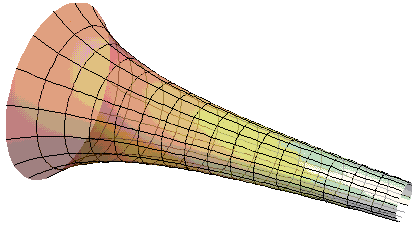Infinity is not a simple concept. Unless a care is exercised, especially when dealing with infinity as if it was a common number, paradoxes arise readily.
For example, the sum of a finite set of numbers is well defined and does not depend on the order in which the numbers are added up:
| 1 | = 1 - 1 + 1 - 1 + 1 | |
| = 1 - (1 - 1 + 1 - 1) | ||
| = (1 - 1) + (1 - 1 + 1) | ||
| = 1 + 1 + 1 - 1 - 1 | ||
| = 1 + 1 + 1 - (1 + 1) | ||
| etc. |
Regrouping of the terms does not change the result. However, it is a well known fact that the infinite sum
Similarly, expressions like ∞ / ∞ or ∞ - ∞ are best left undefined.
In the ancient times, Zeno of Elea (5th BC) came up with a few paradoxes that have been debated ever since.
In the medieval times, philosophers stumbled on the difficulty of thinking of a line as an infinite collection of points. On one hand, it looked like a longer segment should contain more points than a longer one. On the other hand, any two line segments are easily set into a 1-1 correspondence, implying that they have the same number of points. So it appeared as if there were two infinities that were simultaneously different and equal. (Galileo tried to resolve the paradox by allowing infinitesimal gaps between the points.)
Hotel Infinity - even when full - is ever ready to accommodate new arrivals.
Now imagine the surface of revolution obtained by revolving the hyperbola

It can be shown that such a surface has an infinite area but encloses a finite volume. At first sight it may not look like a big deal, but with one more effort, imagine having to paint the surface area. Surely, faced with that task, one would need an infinite amount of paint which seems to constitute an unsurmountable obstruction to fulfillment of the job. However, ingenuity comes to the rescue. Fill a pail equal in volume to that enclosed by the revolving hyperbola and pour the paint into the horn opening. Naturally, the paint will fill the horn and simultaneously paint its surface.
We shall discuss some of these issues on separate pages.
References
- E. Maor, To Infinity and Beyond, Princeton University Press, 1991, p. 84.
- R. Rucker, Infinity and the Mind, Princeton University Press, 1995, p. 5.
- What Is Infinity?
- What Is Finite?
- Infinity As a Limit
- Cardinal Numbers
- Ordinal Numbers
- Surreal Numbers
- Infinitesimals. Non-standard Analysis
- Various Geometric Infinities
- Achilles and the Tortoise
- Tristram Shandy's Paradox
- Infinity and Probability
- Infinite Border, Finite Area
- Rectilinear Paradox
- Infinite Rod
- A Note on Cavalieri's Indivisibles
- Is a Point a Part of a Line?
- Interactive Mathematics Miscellany and Puzzleshttp://www.cut-the-knot.org/WhatIs/Infinity/Paradoxes.shtml
댓글 없음:
댓글 쓰기